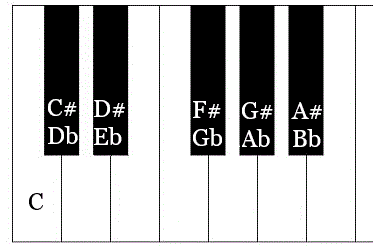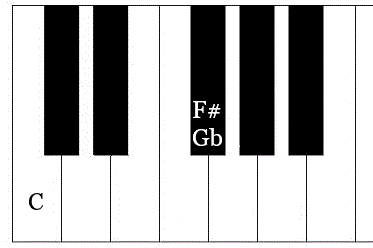The piano keyboard holds many beautiful and interesting patterns. The keyboard can also look a little overwhelming for those who are just starting out! Fortunately, you can sound like a great pianist just by playing a few keys.
In this newsletter, we will explore the black keys on the piano. We will first learn the basic keyboard pattern. Then, we will explore the names of the black keys on piano. Finally, we will learn a few patterns to practice and throw in a few lessons from Skoove for fun! Let’s go!

What can I use the black keys on a piano for?
You can try improvising with only the black keys on the piano. Push down two or three groups of black notes at a time and experience the different sound qualities you can find. You will find that it sounds great no matter what you play! These scales have a certain ethereal, floating quality to them that sounds wonderful.
Try pushing down the sustain pedal when you improvise with these keys. Pressing the sustain pedal will surely add to the pleasure of improvising on the black keys. These notes sound great together because it is nearly impossible to create dissonance between them!
The basic keyboard pattern
You may have noticed that the piano keyboard is laid out in a repeating pattern on two black keys followed by three black keys. This pattern of black keys on piano is repeated up and down the keyboard anywhere from 4 to 8 times depending on how many keys your instrument has. Learning to identify this pattern is crucial to orienting yourself on the piano!
Check out this pattern below:

Can you identify this pattern on your keyboard?
For reference, middle C on the piano is found to the left of the group of two black keys.

Everytime you see this key, it is the note C. You can build the rest of the white keys from this note. If you need some review of the white keys, perhaps trying out an app to learn piano like Skoove would be a great option for you!
The names of the black keys
All of the black notes on piano have two basic names. Each of these piano keys is either called a sharp (♯) or a flat (♭) depending on the context. Check them all out here:

What is a sharp?
In music, when something is sharp, it means that the pitch is raised by one half step, or one key on the piano. The symbol is this: ♯.
What is a flat?
In music, when something is flat, it means that the pitch is lowered by one half step, which is the same thing as one key on the piano. The symbol is this: ♭.
How are the black keys on a piano named?
The black key between C and D we either call C♯ because it is one half step above C or we call it D♭ because it is one half step lower than D.

The black key between D and E we either call D♯ since it is one half step above D or we call it E♭ because it is one half step below E.

The black key between F and G we either call F♯ because it is one half step above F or G♭ because it is one half step below G.

The black key between G and A we either call G♯ because it is one half step above G or we call it A♭ because it is one half step below A.

Finally, the black key between A and B is either called A♯ because it is one half step above A or it is called B♭ because it is one half step below B.

How to play with the black keys
If you simply play all the black notes on piano, you will make a great scale. The scale is called the pentatonic scale. Depending on where you place the root note, the pentatonic scale that involves all the black keys is either called the E♭ minor pentatonic scale (because the root is E♭) or it is called the G♭ major pentatonic scale (because the root is G♭).
Try some songs!
Skoove has many great lessons and songs that use the black notes on piano. First, check out how you can use the black keys to make the blues scale:
The blues scale is a form of the minor pentatonic that includes an added tone called the “blue note.” The blue note adds a depth of emotion to the minor pentatonic scale and is extremely useful when playing blues music on the piano.
Here you explore all the black keys and learn a great melody! Plus, you will receive some more helpful tips on how to sound great on the piano with just the black keys.
After that, check out the lesson on the classic melody “In the Hall of the Mountain King.”
In this lesson, you learn how to read in the key signature of B minor which includes two sharp black keys: F♯ and C♯.
Once you have taken a look through all of those lessons, have a look at this famous piece by Claude Debussy called “Clair de Lune”:
“Clair de Lune” makes great use of the piano black keys. Plus, it is a timeless piece of piano music that every developing piano student should learn at some point!
Conclusion
The black keys on the piano form a crucial piece of the puzzle that is the piano keyboard. You can make beautiful sounding music with only these keys if you set your mind to it! You can also incorporate your knowledge of these keys to enter a huge world of piano repertoire, scales, and chords.
Learning about the black keys on the piano is easy and fun with Skoove. Intuitive lessons coupled with real-time feedback on your playing make it enjoyable and exciting to practice. Additionally, Skoove has lessons for all ability levels and interests. Check it out this week!
Author of this blog post:

Eddie Bond is a multi-instrumentalist performer, composer, and music instructor currently based in Seattle, Washington USA. He has performed extensively in the US, Canada, Argentina, and China, released over 40 albums, and has over a decade experience working with music students of all ages and ability levels.















